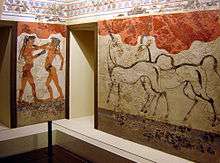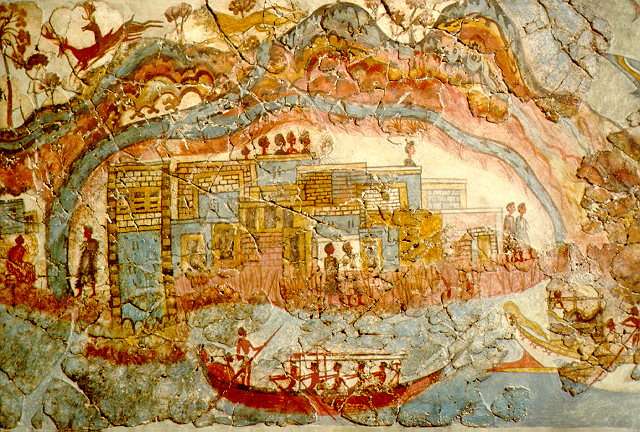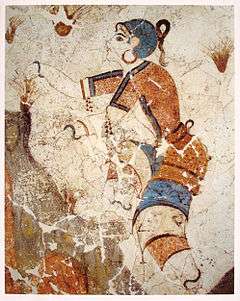Wall Paintings of Thera
The wall paintings of ancient Thera are famous frescoes discovered by Spyridon Marinatos at the excavations of Akrotiri (Santorini).

Importance
Excavated from 1967 to 1974, the wall paintings provide a crucial window into Santorini's history, depicting the early Aegean world as a highly developed society. Of all the findings unearthed at Akrotiri, these frescoes constitute the most significant contribution to present-day knowledge of Aegean art and culture. In their technique, style, and thematic content, the paintings are invaluable objects of study for archaeologists, art historians, zoologists, botanists, and chemists. Originally displayed on the walls of ancient Theran aristocratic estates, the paintings render ancient figures, customs and historical events.

Minoan Town Fresco, Akrotiri, Thera.
Technique and Palette
To prepare the stone walls of the buildings for frescoes, the walls were first covered with a mixture of mud and straw, then thinly coated with lime plaster and lastly layers of fine plaster. The palette of the paintings consists of white (from the lime plaster), red (derived from ferrous earths and haematite), yellow (from yellow ochre), blue (either Egyptian blue,purrple, or possibly azurite), and mineral black. The ancient Theran artists made full use of their colors: yellow was used for the golden fur of lions or the skin of youths, and as a stand-in for light green for painted plants such as myrtle. Blue was used as a dark gray to indicate birds, animal pelts, fish scales, and the shaven heads of young figures. Deep blue was also used to suggest the deep green of ivy, papyrus, lily, reeds, and palm trees. White indicated the pale skin of female figures while red was used for the darker, sun-tanned skin of males.[1]

Saffron gatherer in fresco from Akrotiri, Thera.
Reproductions
3-D reproductions of the paintings were sponsored by the Thera Foundation as a commission to Kodak Pathé of France. The Kodak Pathé technique has also been used in the reproductions of the Lascaux cave paintings and the Tomb of Sennefer.
Exhibitions
Past
• Hildesheim, Germany at Roemer and Pelizaeus museums (1993): "Egyptian-Minoan Relations" • Vienna, Austria at the Vienna City Museum (1994): "Pharaohs and Foreigners, Dynasties in the Dark" • Paris, France at Salon International de Musées et de Exposicion SIME (1994) • Santorini, Greece at the Petros M. Nomikos Conference Center (1997): "First International Symposium on the Wall Paintings of Thira" • Paris, France (1999 - 2000): "Europe in the Time of Ulysses, Gods and Heroes of the Bronze Age"
Present
The reproductions are currently on display at Santozeum, a museum in Santorini that doubles as a private residence. The reproductions are featured on the house's inner walls, presented as they were intended to be viewed in antiquity, as interior embellishments for Aegean homes.
| Wikimedia Commons has media related to Minoan frescos in the National Archaeological Museum of Athens. |
References
- ↑ Christos Doumas, The Wall-Paintings of Thera (Athens: Thera Foundation, 1992), 18.